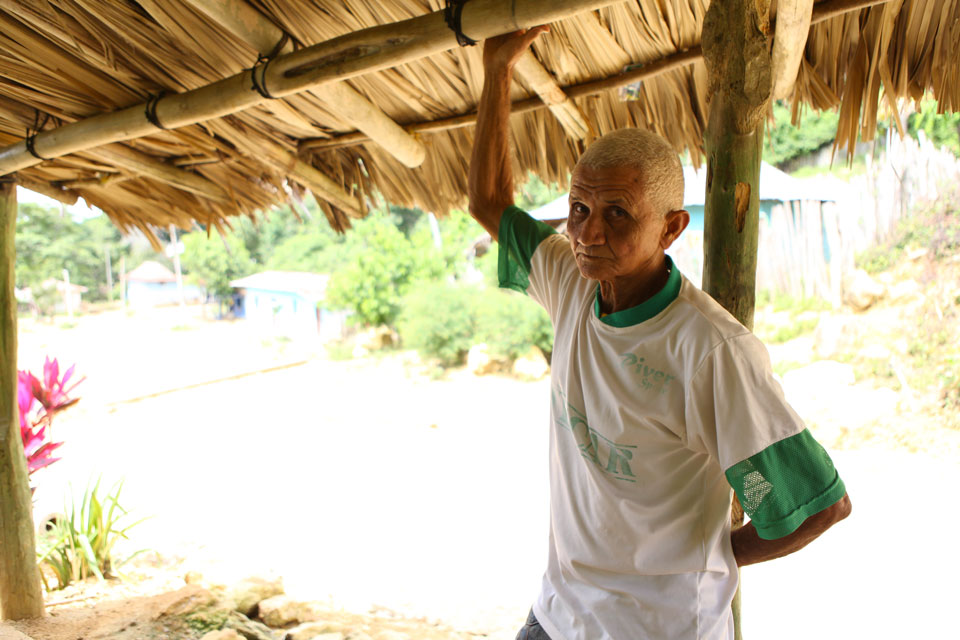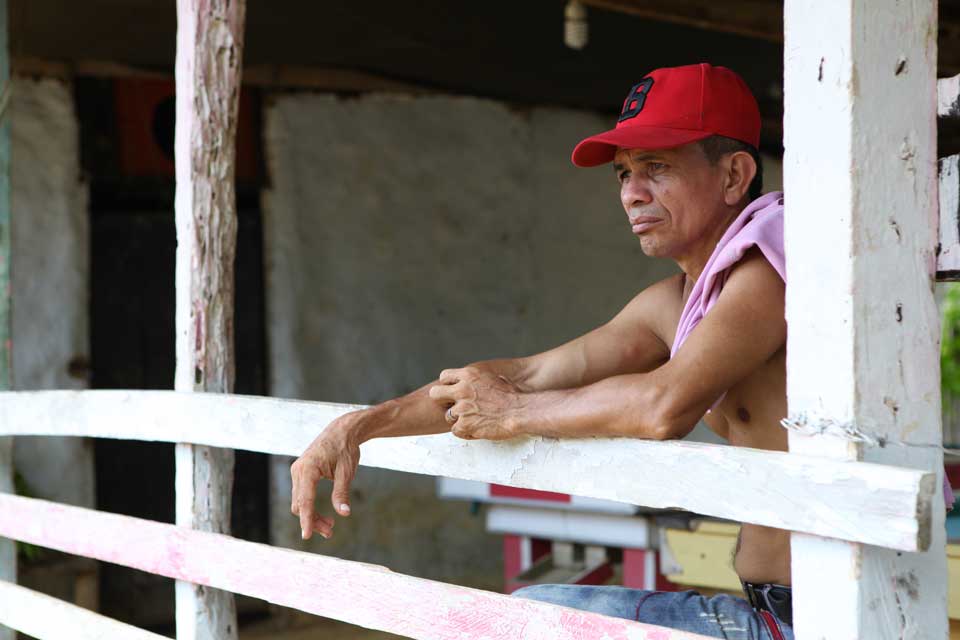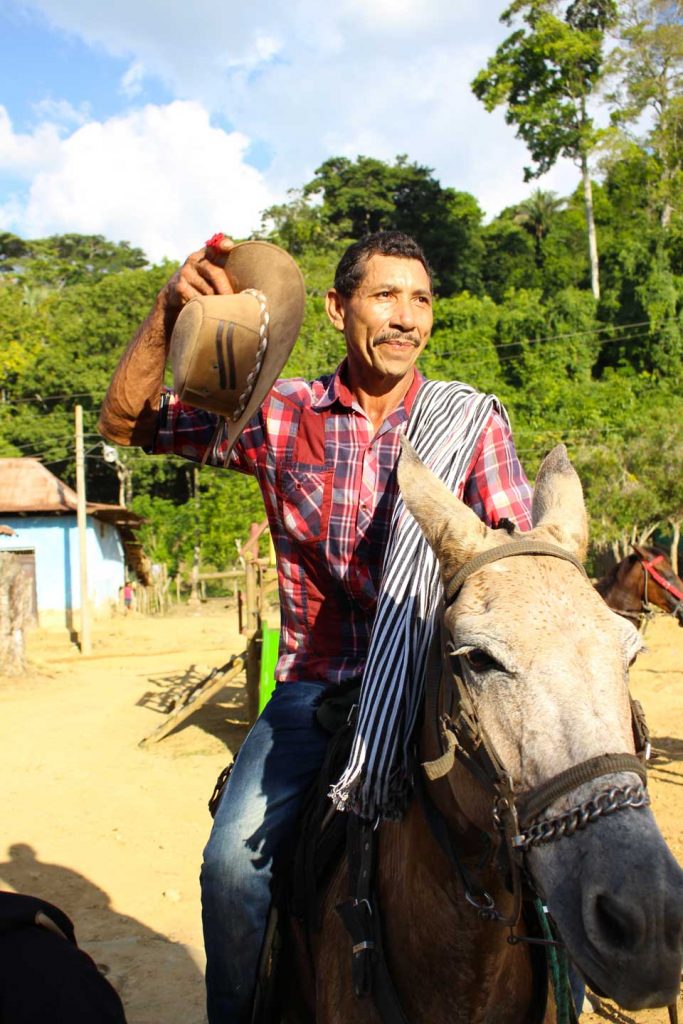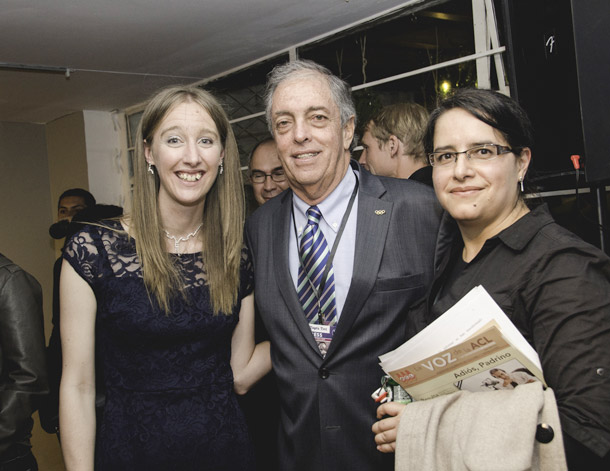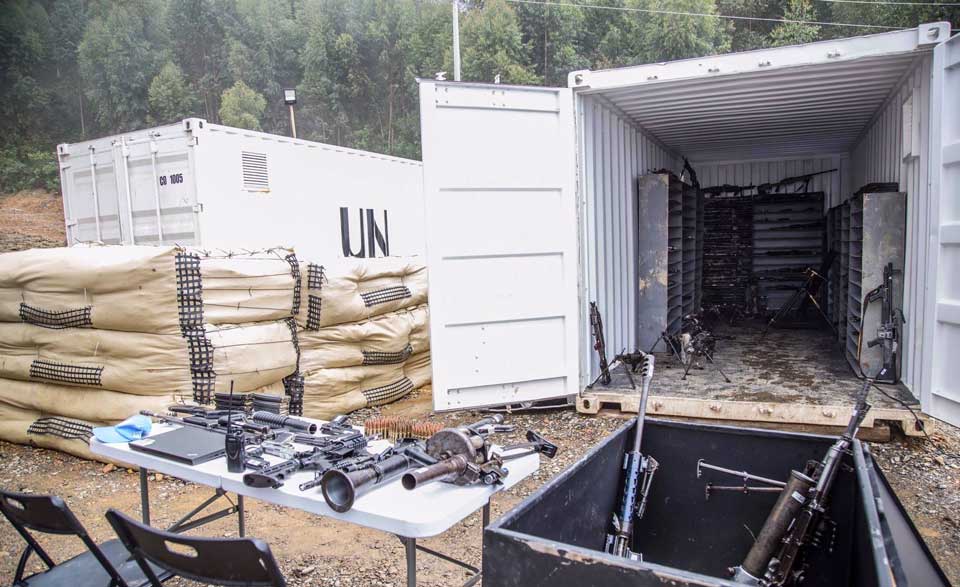
The people of Chengue celebrate their first fiestas patronales in more than 20 years. Photo: Nico Parkinson
Sixteen years ago, residents of Chengue, a small village in northern Colombia were forced from their homes by paramilitaries. Now, the chengueros are celebrating the possibility that they can return.
The 2016 delivery of a land restitution sentence brought little solace to the residents of Chengue, but when government agencies began delivering on orders, despair turned to joy and inspired a party in this forgotten village.
For the past sixteen years, residents of Chengue have found few reasons to dance. They fled their small village in the heart of the tropical hill country of northern Colombia after living through a bloody massacre perpetrated by a group of paramilitaries in 2001. That day, 60 uniformed killers ended the lives of 27 villagers with hammers, rocks, and machetes. They also burned down dozens of houses. They told the survivors never to return, because from that point forward “Chengue would be gone forever.”
This year, hundreds of chengueros proved their attackers wrong and organised the first fiestas patronales in more than 20 years. In the same plaza where their fathers, brothers, uncles, and cousins were killed, residents danced to the local rhythms of porro and gaita music. Historically, the festivities – held in the first week of July – were colourful scenes of people dancing, women stirring pots of sancocho, poker-faced elders playing cards and drinking beer, excited children flipping marbles on the roads and agile horseback riders on display.
“This is the first time in nearly 16 years that we see the night fall in Chengue,” said Jairo Barreto López, President of the Chengue Victims Association. “There are so many mixed feelings right now, people who want to cry and people who want to laugh.”
The recent fiesta was the latest attempt by Chengue families to show one another that their former lives are not gone – rather, those two-day festivals that once made Chengue famous are back with the same pomp and pageantry of days past.
Pol Cucala and Nico Parkinson created the documentary; The Long Journey Home: A Colombian Story of Land Restitution, about their experiences in the Chengue community.
Chengue is located in the region known as Montes de María, where, following the demobilisation of Colombia’s paramilitary groups, the government began the slow process of land restitution and reparations for victims. A decade after the attack, the government created the Land Restitution Unit (LRU), which has set out to recognise the land rights of victims, provide reparations, and allow victims to return to their homes and their lives.
By the time the LRU was created, the more than 300 chengueros had nearly lost all hope for any justice related to the attack. The tragedy, in their eyes, seemed tethered to a corrupt and bureaucratic system. In 2006, a local judge determined that the police and the Colombian armed forces had not done their job in preventing the attack, awarding a settlement of more than a million US dollars. Eventually, approximately 100 surviving families were paid around USD$10,000 each, much less than the amount the court originally awarded. Then in 2008, the man who had ordered the attack, Juancho Dique, was sentenced to just eight years in prison as part of the government’s paramilitary demobilisation program. He was released in 2015.
- Photo: Pol Cucala
- Photo: Nico Parkinson
- Photo: Nico Parkinson
- Photo: Nico Parkinson
- Photo: Nico Parkinson
Path to restitution
In 2012, the LRU started a land restitution case for 37 families from Chengue. However, due to complicated land issues related to informal ownership and most of the land belonging to the state, the case hit a dead end and languished in process while hundreds more restitution cases were piled onto the understaffed agency.
“Chengue was a very complicated case, and for us to properly recognise the land rights of the victims, we first had to clear up issues with land use and ownership,” explains LRU social worker and case manager Elina Rivera. “Without establishing a route to bring this case to fruition, these victims would likely lose the chance to be able to pass their land on to the next generation or have the option to sell. In some cases, that link to their land might be lost forever.”
Land restitution is a complex and expensive process. A number of international organisations, including the USAID-funded Land and Rural Development Program where I work, are supporting the Land Restitution Unit and local communities to ensure the cases move forward and delivery on judges’ rulings.
The programme began working with the LRU in Montes de María in 2014 to identify bottlenecks in the restitution process. To this end, the two partners facilitated a “case clinic” – a multi-institutional platform including national agencies related to land administration, local government partners, and restitution judges – to work out the barriers that were holding up cases like Chengue.
“The case clinic methodology gave us the tools to get through a larger number of cases. By removing bottlenecks, we can provide better responses to the families who are expecting answers,” explains the LRU’s regional director in Montes de María, Álvaro Tapia Castelli.
In April 2016, a judge ruled in favour of 37 Chengue families, recognising their land rights to more than 72 hectares of land as well as ordering government entities to undertake comprehensive reparations such as new houses, a paved road, and investments in agriculture. The sentence was yet another step in delivering justice to Chengue’s survivors and setting them on the path back to their village.
Pieces in place
Immediately after the ruling, the same USAID land rights programme facilitated the work of a post-ruling monitoring group that includes the Chengue Victims Association, local government leaders, the LRU and relevant land agencies. Each month, the group follows up on progress in compliance with the judge’s orders in the town of Ovejas.
“To those from Chengue, the restitution process might seem slow, sixteen years since the massacre, sixteen years since, as they call it, the state abandoned them. But if we look at this ruling, it brings together all of these institutions and the power that entities need to work with these types of communities,” says LRU social worker Elina Rivera.
In June 2017, the National Land Agency began delivering on its duty to formalise the parcels of land included in the sentence. The agency issued property titles for 27 lots, mostly located around the main road and the village square.
“We have been waiting a long time, and you have to appreciate any small step that is made. We will need the help of partners to get things done. Now we hope the momentum will continue and we will see our houses rebuilt,” says Barreto, who was also the main organiser of the festivities. “We didn’t organise this party for the sake of throwing a party. We did it to show everybody that Chengue did not die. Chengue is still alive.”
Land Restitution Unit
The Land Restitution Unit (LRU) was created in 2011 under Colombia’s comprehensive Victims’ Law, and was given a mandate of ten years to process hundreds of thousands of restitution cases and deliver to restitution judges. The LRU began by assisting campesinos in relatively peaceful areas like Tolima and Montes de María, and has since intervened in nearly every department of the country.
To date, the LRU has received more than 106,000 land restitution requests, and nearly half of those are currently in the administrative process. Six years after its creation, judges have issued rulings to restitute more than 4,000 parcels of land, consisting of more than 200,000 hectares.
More than 10,000 people who survived the violence and were forced to leave their homes have processed land restitution claims with the LRU.
Nico Parkinson

